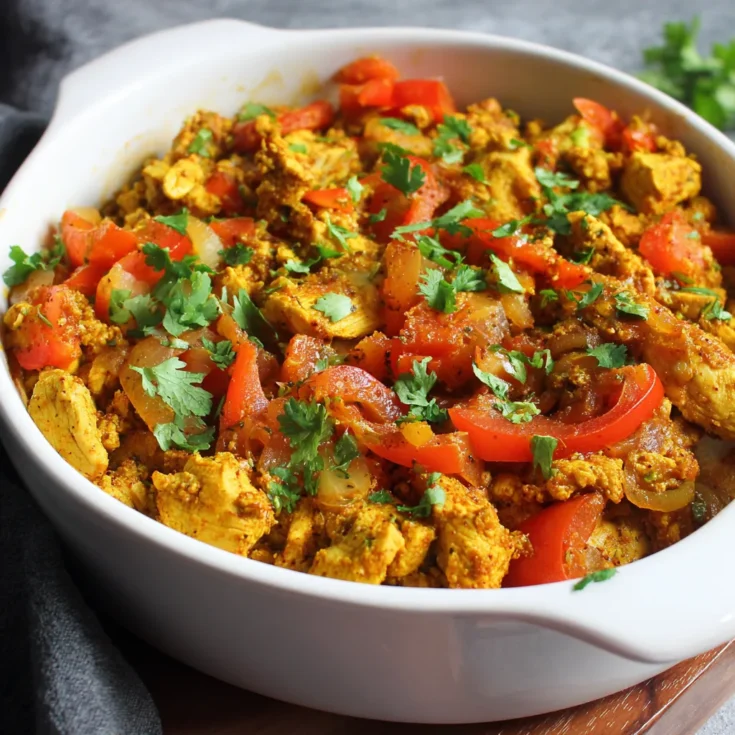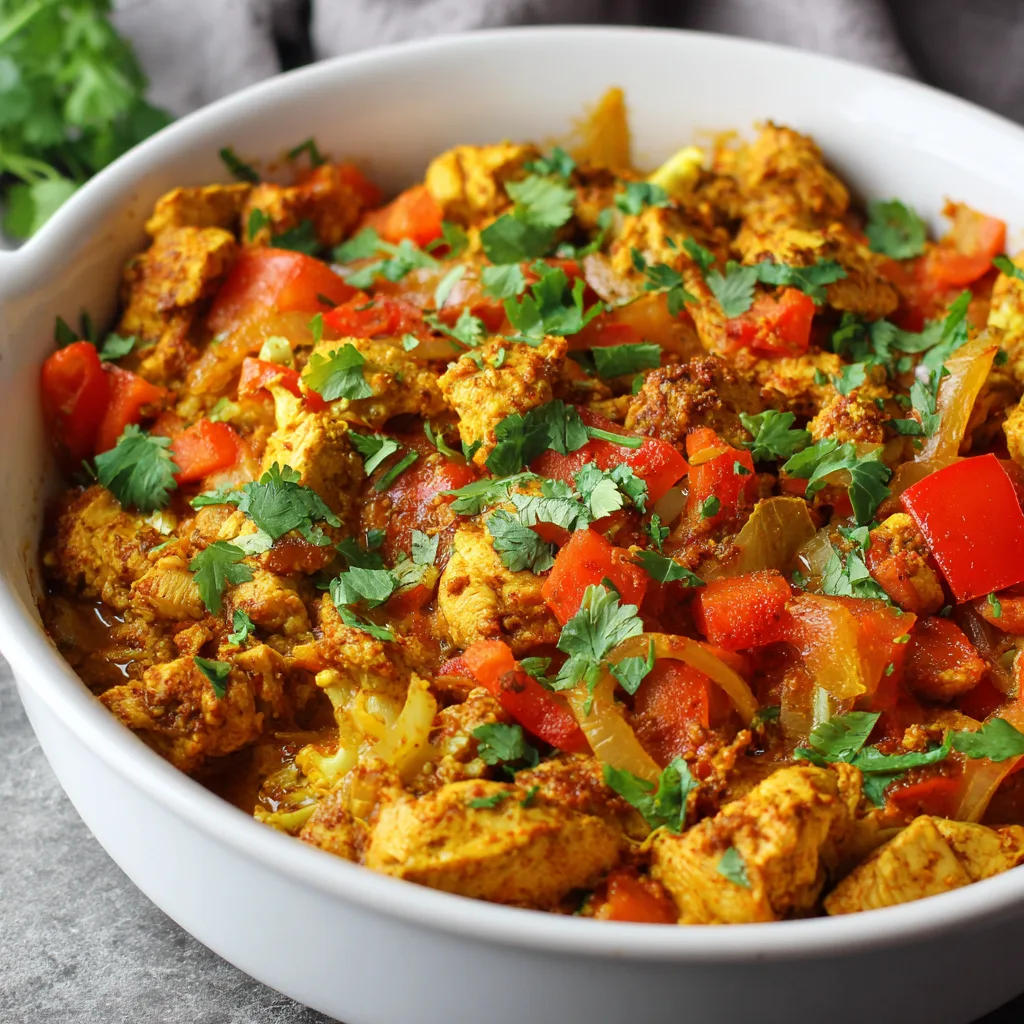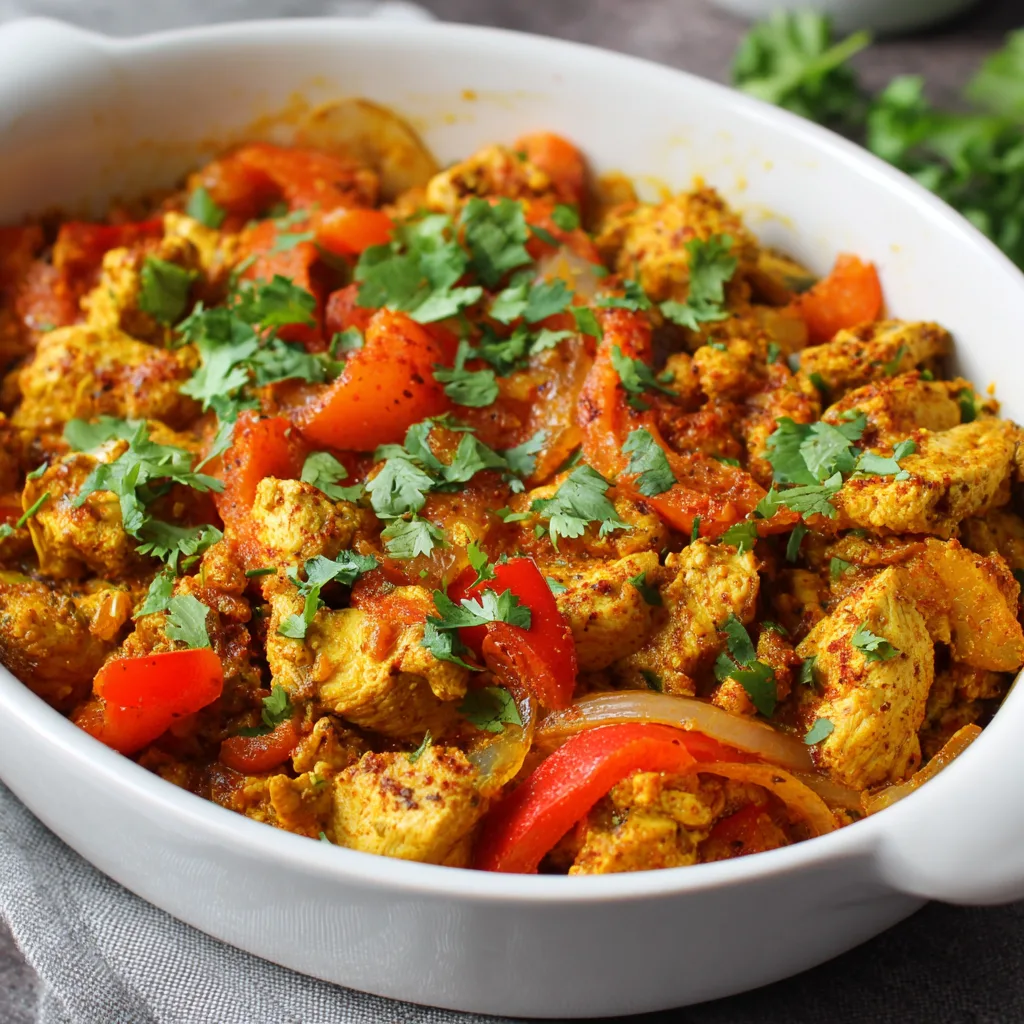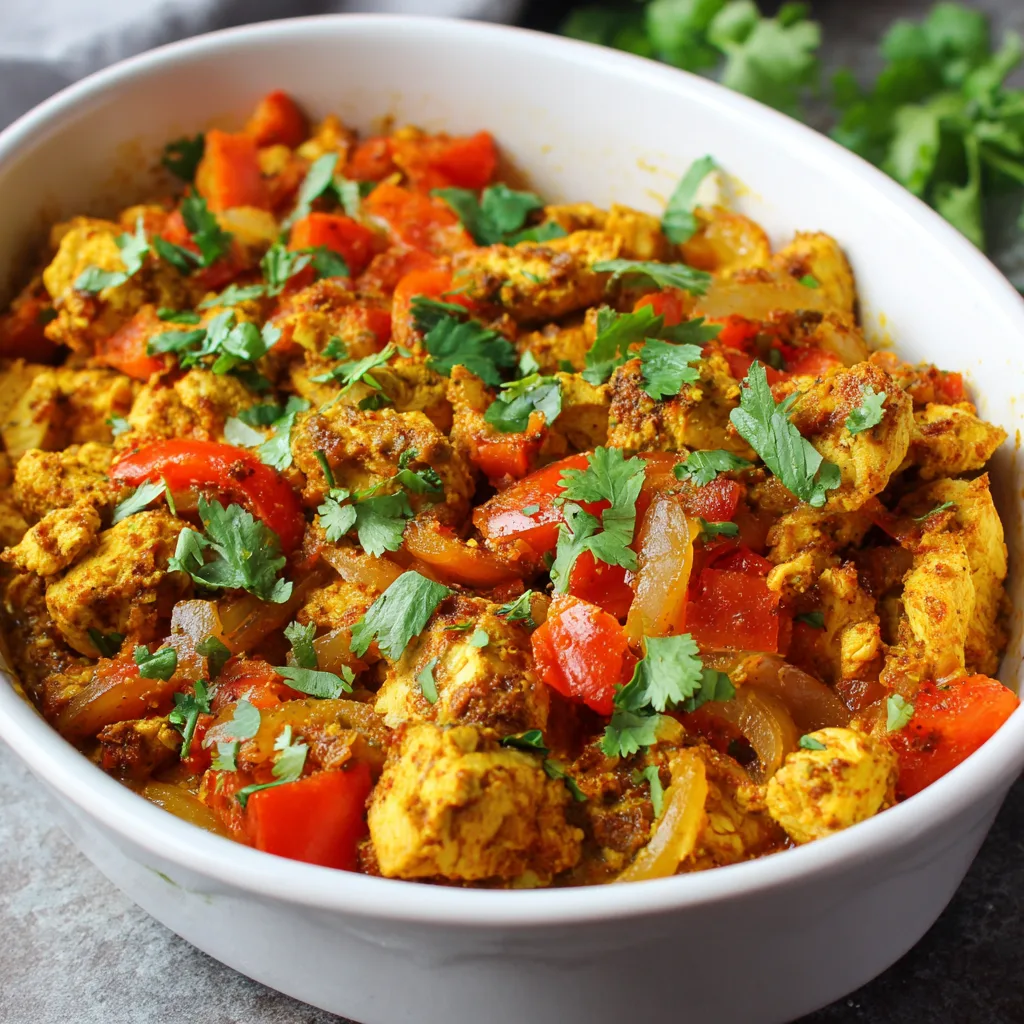Healthy Baked Turkey Curry – Introduction
Healthy Baked Turkey Curry offers a delicious and nourishing twist on a classic favorite. This lightened-up dish combines lean turkey with bold, aromatic spices, then bakes the protein for a healthier preparation. Unlike traditional stovetop curries that rely on oil-heavy frying, this version reduces excess fat without sacrificing depth of flavor.
The result? A vibrant and satisfying curry with golden, tender turkey pieces nestled in a rich, savory sauce. What makes it stand out is its use of wholesome ingredients that prioritize wellness while delivering on taste. This dish fits perfectly into balanced meal plans, offering comfort and nourishment in every bite.
Choosing lean turkey as the base adds multiple health benefits. Turkey is naturally low in saturated fat and rich in essential nutrients such as B-complex vitamins, selenium, phosphorus, and zinc. Together with antioxidant-rich spices and vegetables, this baked turkey curry becomes a complete, heart-friendly meal that supports an active, healthy lifestyle.
Why Choose Turkey for Curry?
Turkey is an excellent protein choice for curries. It’s low in fat yet rich in muscle-building protein, making it ideal for those aiming to stay fit and energized. Each serving provides high levels of B3, B6, and B12, which support metabolism and brain health. It also contains important minerals like iron and selenium that strengthen immunity and maintain red blood cell health.
Beyond its nutritional profile, turkey supports satiety, helping you feel full longer with fewer calories. This can aid in weight management and reduce unhealthy snacking. Its naturally mild flavor also allows the spices in curry to shine without being overpowering.
Whether you’re aiming to eat cleaner, manage your weight, or simply enjoy a lighter curry, baked turkey brings balance, flavor, and nutrition to the table.
Nutritional Profile of Turkey Meat
Turkey delivers outstanding nutritional value in every bite. It’s a lean protein powerhouse that supports muscle repair and overall wellness. A typical 100-gram serving of cooked turkey breast provides around 290 calories and a generous 30 grams of protein. Its fat content remains low, especially when using skinless cuts or turkey breast mince with less than 2% fat.
This impressive protein-to-fat ratio makes turkey ideal for health-conscious meals. It fuels the body without adding unnecessary calories or saturated fat. Compared to many red meats, turkey is easier to digest and more heart-friendly.
Beyond macronutrients, turkey is also rich in essential vitamins and minerals. It contains vitamin B3 (niacin) for energy production, B6 and B12 for brain and nerve function, and choline, which supports liver health and cognition. You’ll also find iron, selenium, and phosphorus—key for immunity, thyroid balance, and bone strength.
Thanks to this robust nutritional profile, turkey plays a central role in healthy meal planning, especially when paired with other nutrient-dense ingredients.
Spices and Ingredients for Health
The spices in baked turkey curry do more than add flavor—they boost your health. Turmeric offers powerful anti-inflammatory benefits and may improve joint and skin health. Cumin and coriander help aid digestion while supplying antioxidants. Ginger and garlic strengthen immune defenses and support metabolic balance.
Each ingredient works synergistically to promote wellness while enhancing the dish’s warmth and aroma.
In terms of creaminess, choosing coconut milk or low-fat yogurt allows flexibility. Coconut milk lends a rich, dairy-free texture and medium-chain fats that provide quick energy. Meanwhile, low-fat yogurt adds creaminess with extra protein and calcium—ideal for lighter, tangy finishes.
Add colorful vegetables such as peas, spinach, or bell peppers for added fiber, vitamins, and visual appeal. This combination results in a vibrant curry that’s both comforting and clean-eating approved.
Comparison with Traditional Curry Methods
Traditional curries often rely on oil-heavy frying techniques. While flavorful, these methods add unnecessary calories and saturated fats. In contrast, baking the turkey keeps it lean and moist without excess oil. It reduces fat content and prevents overcooking—especially when using skinless turkey breast or 2% fat mince.
By switching to the baked method, you’re trimming down without giving up satisfaction.
For a heart-healthy plate, pair your curry with whole-grain rice or quinoa. These grains deliver essential fiber and help stabilize blood sugar. If you’re aiming for fewer carbs, cauliflower rice offers a low-calorie substitute that still soaks up the flavorful sauce.
Ultimately, baked turkey curry outperforms traditional versions by combining flavor, nutrition, and simplicity—making it a smart choice for everyday wellness.
Overview of Baked Turkey Curry vs Conventional Simmered Versions
Baked turkey curry introduces a refreshing change to the typical stovetop method. Instead of frying or long simmering, the turkey bakes gently in the oven. This method helps retain moisture, preventing the meat from drying out—especially when working with lean turkey breast or 2% fat turkey mince.
Baking also simplifies preparation. You season the turkey, bake it until golden, then fold it into a simmered curry sauce. The process minimizes stovetop mess and creates consistent results.
There are several ways to apply this baked approach. One option is to bake seasoned turkey mince in a casserole-style dish, then break it apart into the curry for a hearty texture. Another idea is oven-roasting turkey tikka-style chunks, which develop a delicious outer crust before simmering them in a spiced tomato or coconut curry base.
This technique blends well with global curry profiles and makes meal prep more flexible—ideal for batch cooking or weeknight dinners.
Common Styles and Global Influences
Healthy baked turkey curry draws from several culinary traditions. A popular inspiration is British-Indian fusion, where warm spices meet tomato-rich sauces. These curries often use leftover roasted turkey, blending convenience with bold flavor. Versions like these have become comfort food staples across UK kitchens.
You’ll also find rich coconut-based styles influenced by Thai and South Indian cuisine. These versions typically include lemongrass, lime, and gentle spices, resulting in a fragrant and mild curry. For instance, the “coconut turkey curry in a hurry” captures that creamy, aromatic feel while staying quick and healthful.
Online forums and modern food blogs often showcase these hybrid curries, where traditional flavors meet new, lighter techniques. From tomato-based gravies to coconut milk blends, the world of turkey curry continues to evolve with healthy eating in mind.
Healthy Variations and Low-Carb Adaptations
Baked turkey curry is endlessly adaptable to suit different diets and wellness goals. One nutrient-packed option is a turkey and chickpea curry. The chickpeas add plant-based protein, fiber, and texture—turning the meal into a filling, gut-friendly dish. It’s ideal for those focused on blood sugar control and heart health.
For low-carb and keto-friendly versions, the base ingredients shift slightly. Swap coconut milk for unsweetened almond cream or stick with full-fat yogurt to add creaminess without excess carbs. Use cauliflower rice instead of grains to keep things light but satisfying.
These flexible variations help you align with personal health goals without missing out on flavor. Whether you’re cutting carbs, boosting fiber, or reducing dairy, there’s a version of healthy baked turkey curry that fits seamlessly into your plan.
Preparing Turkey: Selecting Lean Cuts or Leftovers
To create a healthy baked turkey curry, start with the right protein base. Skinless turkey breast is ideal for its low-fat content and tender texture. You can also use 2% fat turkey mince if you prefer a heartier, ground meat version. If you have leftover cooked turkey, that’s a great option too—it reduces prep time and prevents waste.
When using leftovers, avoid overcooking. Reheating turkey too long can cause it to become dry and chewy. To maintain juiciness, add cooked turkey only at the final simmering stage. This gentle reheat method helps preserve moisture and flavor.
Whether you’re starting fresh or using leftovers, the goal is clear: keep it lean, flavorful, and tender with every bite.
Baked Turkey Preparation
For baked turkey curry, baking replaces stovetop frying. This approach cuts down added fats while still creating depth and color.
Start by preheating your oven to 180°C (356°F). Cut turkey into bite-sized pieces or shape mince into flat patties. Season generously with your spice mix—try turmeric, garlic powder, cumin, paprika, and salt for bold flavor.
Place the seasoned turkey on a parchment-lined tray or in a baking dish. Bake for 15–20 minutes, depending on size and thickness. The turkey should be fully cooked but not dry. It’s best to check at the 15-minute mark to avoid overbaking.
Once golden and cooked through, set the turkey aside while you prepare the curry base.
Cooking the Curry Sauce
A great curry starts with bold, layered flavors. Begin by heating a teaspoon of oil in a deep skillet or pan over medium heat. Add finely chopped onions, and sauté until they turn soft and lightly golden—usually 4–5 minutes.
Next, stir in fresh garlic and ginger, cooking for one minute until fragrant. Now it’s time to bloom your spices—this step deepens their flavor. Add turmeric, ground cumin, coriander, garam masala, cinnamon, and a pinch of cayenne or chili powder for heat. Stir continuously for 30 seconds to keep spices from burning.
Once the spices are toasted and aromatic, you’re ready to build the sauce.
Combining and Finishing: Bake + Curry Method
Pour in chopped tomatoes or passata, followed by a splash of low-sodium broth or water. Let the sauce simmer for 8–10 minutes, reducing slightly and thickening naturally. Stir occasionally to avoid sticking.
Once the base is smooth and bubbling, gently fold in the baked turkey pieces. This step infuses the meat with flavor without overcooking it. Finish the curry with a splash of coconut milk for richness or low-fat yogurt for a lighter, tangier finish.
To boost color and nutrition, toss in vegetables such as peas, spinach, or zucchini. These add fiber and vibrancy, creating a wholesome one-pan meal. Simmer for 5 more minutes, then taste and adjust seasoning as needed.
Your healthy baked turkey curry is now ready to serve—fragrant, nourishing, and packed with balanced flavor.
Frequently Asked Questions About Healthy Baked Turkey Curry
Can you make curry with cooked leftover turkey?
Yes, you can! Leftover cooked turkey works perfectly in baked turkey curry. Just add it at the final simmering stage to avoid drying it out. This method saves time while preserving flavor and moisture. It’s a smart way to repurpose holiday or meal-prep turkey.
Healthy Baked Turkey Curry – Easy Low Fat Dinner Recipe

This healthy baked turkey curry is packed with lean protein, warming spices, and vibrant vegetables. Whether you use turkey breast, 2% fat mince, or leftovers, the result is a flavorful, heart-healthy dish. Finished with creamy coconut milk or low-fat yogurt, it's light yet satisfying—perfect for weeknight dinners or meal prep.
Ingredients
- 500 g skinless turkey breast or 2% fat turkey mince (or shredded leftover cooked turkey)
- 1 tbsp olive oil or avocado oil
- 1 medium onion, diced
- 2 cloves garlic, minced
- 1 tbsp fresh ginger, grated
- 1 tsp turmeric
- 1 tsp ground cumin
- 1 tsp ground coriander
- ½ tsp cinnamon (optional)
- ¼ tsp cayenne or chili powder (optional)
- 400 g canned chopped tomatoes (or passata)
- 200–250 ml low-sodium chicken broth or water
- 150 ml coconut milk or low-fat yogurt
- 100 g mixed vegetables (peas, spinach, zucchini, bell pepper)
- Salt & pepper to taste
- Fresh cilantro/coriander for garnish
Instructions
▢ Preheat oven to 180 °C (356 °F).
▢ If using raw turkey, season with salt, pepper, and half the spice mix. Bake for 15 minutes or until just cooked. If using cooked turkey, skip baking.
▢ Heat oil in a skillet over medium heat. Sauté the onion until soft.
▢ Add garlic and ginger; cook 1 minute until fragrant.
▢ Stir in turmeric, cumin, coriander, cinnamon, and cayenne. Toast for 30 seconds.
▢ Pour in tomatoes and broth. Simmer for 5 minutes to reduce.
▢ Stir in coconut milk or yogurt. Mix until smooth.
▢ Add turkey (baked or cooked) and vegetables. Simmer for 5–10 minutes.
▢ Adjust seasoning to taste.
▢ Garnish with cilantro and serve.
Notes
• Use low-fat yogurt instead of coconut milk for a lighter option.
• Avoid overcooking turkey, especially if reheating leftovers.
• Add chickpeas or extra greens for added fiber and protein.
• Pair with whole-grain rice or cauliflower rice for a balanced plate.
• Adjust spice level for kids or sensitive eaters by omitting cayenne.
Is turkey curry healthy?
Absolutely. When made with lean turkey, heart-friendly oils, and fiber-rich vegetables, turkey curry becomes a nutrient-dense meal. It’s low in saturated fat, high in protein, and pairs well with whole grains or low-carb sides. A healthy curry can support energy, digestion, and weight management.
What cut of turkey is best for curry?
The best option is skinless turkey breast or turkey breast mince with 2% fat or less. These cuts are lean, protein-rich, and absorb spices well. They also cook quickly and stay juicy when baked, making them ideal for health-focused recipes like baked turkey curry.
Can I make this gluten-free or dairy-free?
Yes, this recipe adapts easily to gluten-free and dairy-free diets. Choose certified gluten-free curry powders, and use coconut milk in place of yogurt for creaminess. These swaps keep the curry rich and flavorful while aligning with dietary needs.
How long does leftover turkey curry last in the fridge?
Leftover turkey curry stays fresh for up to 3–4 days when stored in an airtight container in the fridge. For food safety, make sure the turkey has only been cooked twice: once during roasting or baking, and again when it’s added to the curry sauce.
What to serve with turkey curry for healthy sides?
Pair your baked turkey curry with whole-grain rice, quinoa, or cauliflower rice for a low-carb twist. Steamed greens like spinach or a side of whole-grain naan can round out the meal with fiber and extra nutrients.




